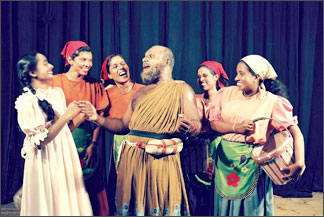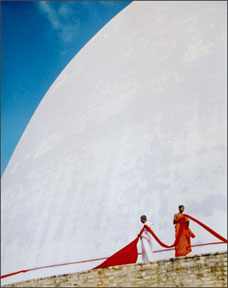Arts
Children's Drama Festival at Nawa Rangahala
Children's theatre - one third of education and
character building:
by Ranga Chandrarathne
 Children's theatre Festival will be held at Nawa Ragahala on December
7 and 8. The festival will make up two dramas; Sinhalese adaptation of
'The Three Bears' (Walas Pawula) and 'The Snow White' (Hima Kumariya). Children's theatre Festival will be held at Nawa Ragahala on December
7 and 8. The festival will make up two dramas; Sinhalese adaptation of
'The Three Bears' (Walas Pawula) and 'The Snow White' (Hima Kumariya).
Both plays were adapted from original plays by veteran theatre
personality Somalatha Subasinghe. Walas Pawula is directed by Dr.
Chandana Aluthge. One of the striking features of these adaptations is
the use of oriental and occidental music for chorus. Music for Hima
Kumariya is composed by M. R. Chulasinghe while music for Walas Pawula
is by Tharupathi Munasinghe.
However, she pointed out that true emotions should not be showed up
in a children's play as children emotionally get attached to the
characters. For children tend to imitate characters in a play or
cartoons shown on television.
Violence shown in cartoons could adversely affect children and it
becomes ordinary to the child. So, bizarre characters and violence are
not good for children. Therefore, heightened emotions are not depicted
in children's theatre.
Special training provided for the actors and techniques of voice
control and speak loud enough to be heard by the children. Language for
the dramas should also be proper so that children will not learn bad
usages.
At the initial stage, very little was known about children's theatre.
However, the idea of children's theatre was shaped by the work of Wimal
Diyasena, W. B. Ratnayake and Mangala Jayawardena.
They conducted series of seminars on Children's Theatre and invited
experts from GDR (German Democratic Republic, as the East Germany known
then). Following these seminars, it was clear that the plays showed were
adult's plays with children as cast. 'Vesanthara Jatakaya' was played
even by kindergarten children.
However, after the initiation into the theatre, Somalatha Subasinghe,
the founder of the Lanka Theatre and Youth Theatre Foundation
(established by the Parliamentary act No. 3 of 2007), had rare
opportunity of studying children's theatre in Czechoslovakia, East
Germany (They were socialist block then) and the Children's Theatre was
given full state sponsorship.
One of the salient characteristic of Childrens theatre in socialist
countries was that adult actors played child roles. For instance, thirty
one year old girl played as an eleven year old girl. This dawn on the
idea that adults can effectively play children characters.
This principle has applied in Sri Lankan productions. For instance
Nadee Kammalaweera played as an eight year old girl in Hima Kumariya at
the age of 25.
Though a person with a dark skin portrayed the character of Snow
White, Snow White embodies inner purity which was vindicated by response
from the audience who highly appreciated Nadee's performance.
Musical plays are produced with combination of Sri Lankan folk and
Western theatre techniques. Certain incidents and dramatic situations
have also been altered to render an indigenous flavour. Traditional
ritualistic music forms such as Yaga and Kolam have been incorporated
into the production which was well-received by the children at rehearsal
stage.
For instance, dwarfs dance, Kolam is used. Drums of Sri Lanka coupled
with Sri Lankan dances have also been used. All these amendments are
being made retaining the dramatic effect of the production. Oriental and
occidental music have been incorporated into the productions.
Explaining the objectives of the Festival, Somalatha Subasinghe
stated that Children's Theatre should be a part of children's education.
However, children should not always go to the theatre. Actors can come
to the class and perform in the classroom on subject familiar to them.
The place of the performance may be in the courtyard or under a tree
depending on the circumstances. Children theatre should be used to bring
up children's personalities and open up their vistas.
In order to instill sense of belonging in children, it is important
to teach them Sri Lankan dance, music, history and social values through
culture. Given the extent to which the Sinhala language has been
degenerated, some children do not know subject and predicate.
In Japan when communication became an issue among children, Japanese
Government introduced a special theatre programme in school to make
children converse through dialogues. So the children's theatre has an
educational value.
Somalatha Subasinghe firmly believes that children's play can be
taken to major cities and villages in order to expose children to plays.
Tickets for the show are sold at a nominal fee as the festival is
sponsored by HNB Assurance PLC in a bid to promote Children's Theatre in
Sri Lanka and thereby contribute to the well being of the country's
future generation. Somalatha Subasinghe hopes that Festival, can, at
least, be held in major cities.
Somalatha dismissed the idea that for children's play, performance
has to be brought down to children's level. One aspect of the festival
is to make children theatre a social events where children with their
family members can enjoy plays. The festival is organised by Lanka
Theatre and Youth Theatre Foundation.
The cast of the musicals comprises Pramudi Karunarathne, Damayantha
Perera, Wishvajith Gunasekera, Chaya Sri Nammuni, Sanjaya Hettiarachchi,
Hiran Abeysekere, Shamaine Gunarathne, Nayomi Gunasiri, Dinuki de Silva,
Mayura Kanchana, Suresh Fernando, Namal Jayasinghe, Geetha Alahakoon and
Ishara Wickramasena.
[email protected]
Fifty two years of exhibition photography
The 52nd International exhibition of the Photographic Society of Sri
Lanka opened at the Harold Peiris Gallery of the Lionel Wendt today and
tomorrow.
|

One of the exhibits - Title: “An offering to Buddha”. |
The Annual Exhibition of the Photographic Society of Sri Lanka has
grown over the past 52 years to become an event widely representative of
amateur photographic talent in the country. The 650 local entries that
came in this year travelled to Colombo from places as distant as
Batticaloa, Maho, Hatton and Matara, to mention a few. There were as
many as 110 entries from overseas, from countries of Europe and Asia.
The exhibition was opened yesterday by the Chief Guest Prof. Ashley
Halpe, at the Harold Peiris Gallery of the Lionel Wendt Art Centre.
There were twenty one awards for different categories of work in colour
and monochrome. These included Gold, Silver and Bronze medals and
certificates of merit.
This exhibition has one of the longest running traditions for
exhibitions of any description in the country.
The Society itself is over 100 years old, and traces its origins to
the early years of the last century. It is associated with the great
names in photography from that era, including Lionel Wendt, one of its
founders.
"Our Society has also been a witness and a participant to the vast
transformation of photography from what it was then to what it is
today," says PSSL President Asoka Siriwardane, in his message on this
occasion.
"At a time when photography is moving to a new platform of "digital
art" and computer technology, along with changing attitudes to a "good
photograph," as a Society I am pleased to say that we have moved with
the times without breaking with our rich past and what is good in the
conventional art forms.
This blend with tradition and change is one of the great challenges
we face in the changing photographic landscape."
It is open to the public from 9.30 a.m. to 8.00 p.m. daily. Admission
is free.
Marvels out of bamboo
by Ranga Chandrarathne
Sri Lankans know very little of the use of bamboo. Bamboo is
basically used for decorations at important occasions such as Weddings
and for Vesak. However, this is a different story at the hand of young
talented handicraftsman M. Wasantha Jayasekara.
Jayasekara who had no interest and aptitude in handy craft was lured
into this fascinating territory after being inspired by watching the
artifacts at national handy craft exhibitions. Then on, his insatiable
desire for excellence in the craft led him to many areas such as wood
carving, spoons from coconut shell and many creations out of coconut
shell.
In 2003, Jayasekara won the Vishkam Ransilu award at the National
Handicraft Exhibition. Thereafter, he ventured into a novel area of
making creations out of bamboo wood. Most of his creations are out of
bamboo wood such as the Tea cart, Kannapuva, microphone stand won the
Janadipathy Rajatha award in 2004, 2005, 2006 and 2007 respectively.
Jayasekara also won awards for his amazing globe out of coconut shell
in 2005 and the merit award for the jewellery box. Jayasekara had no
formal training in the craft and attributed his artistic talents to his
father's influence, a teacher of art.
Although he has been making various creations since 1987, so far he
has not received any assistance from the Government. One of the
obstacles facing the industry is non granting of permits for
handicraftsmen. Although Jayasekara had requested for a permit, so far a
permit was not given. The creations out of bamboo range from
wall-hangings to furniture which are durable and add an allure to the
surrounding. |
